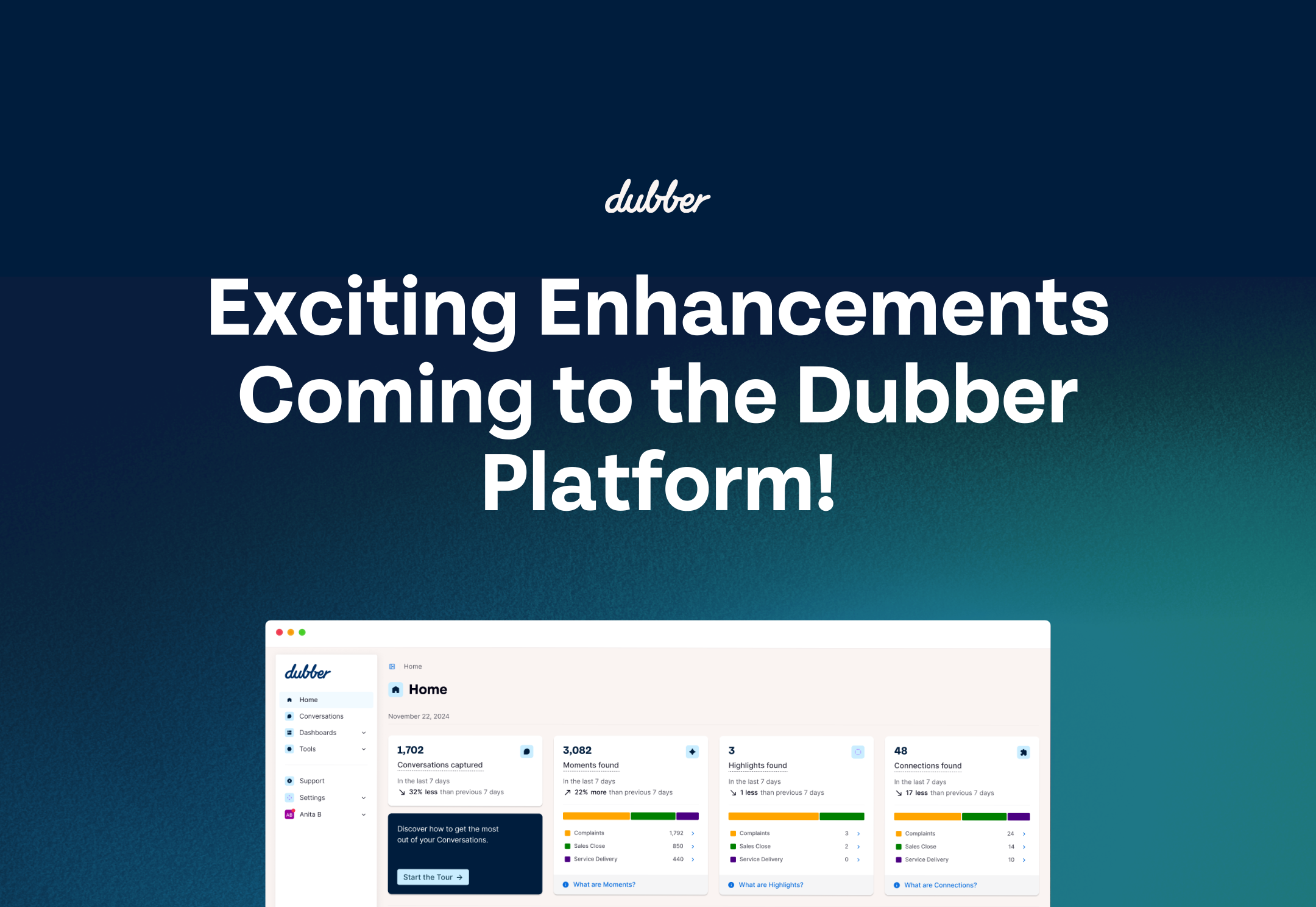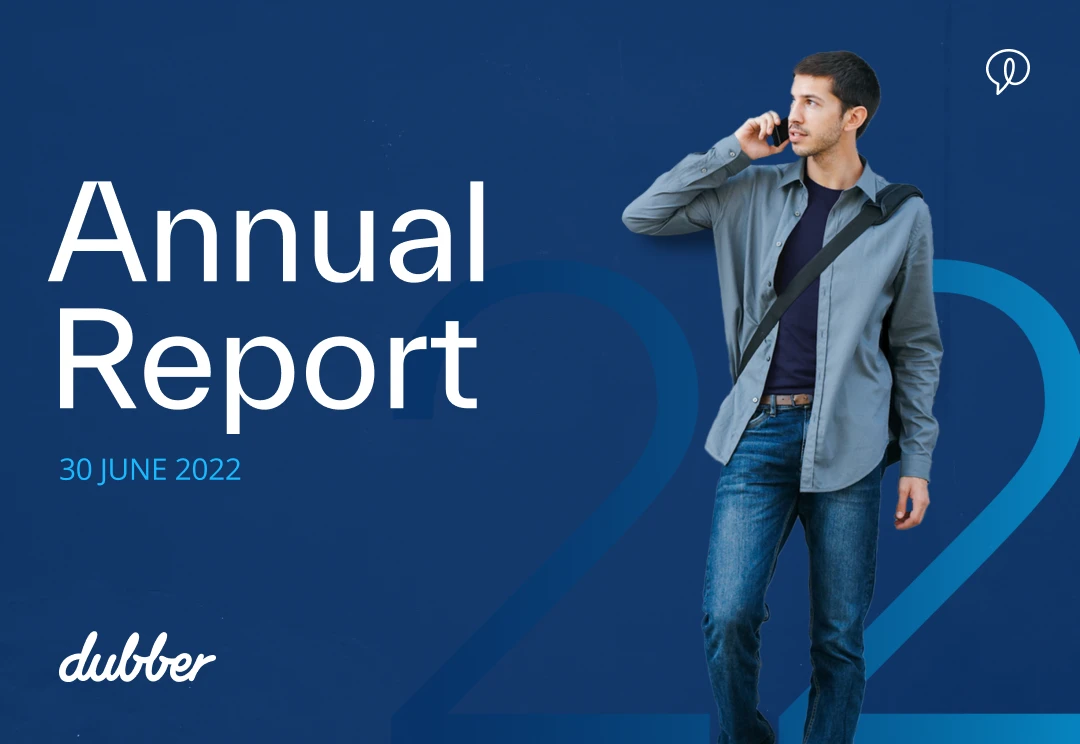
Dubber Corporation Limited (ASX:DUB) the leading conversational intelligence and unified recording platform for service providers and their customers globally, today released its Annual Report to Shareholders for the year ending 30 June 2022.
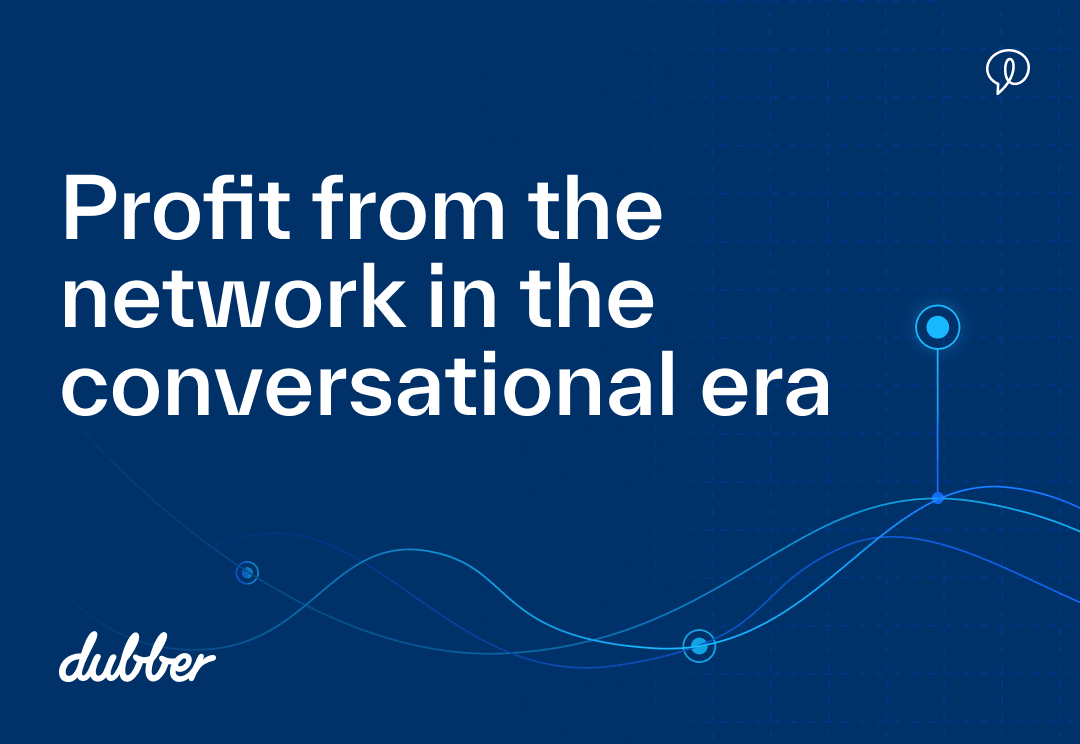
Our recent research with AT&T showed that 72% of businesses lack a clear hybrid-work strategy. The findings also show other sentiments and challenges around Covid-driven hybrid working, including lack of innovation, insufficient oversight and cultural shifts.
But. Hybrid work will be the default by 2024. Half of the work will be performed offsite: 81% believe hybrid work will be the foremost working model by 2024, with 56% of work done offsite.
Artificial intelligence and machine learning were identified as the leading transformative technologies in the survey, with their intrinsic value identified specifically in the areas of employee training, intelligent enterprise search and learning and conversational help.
AI is a great example of the dilemma facing most service providers – how to monetize a transformative technology – does this opportunity get left to those running on the network – or, can AI on both the end-point and in the core of the network usher in a new era of conversation-based services?
Address the challenges at the network level
The issues emerging in addressing both AI and Hybrid Working as opportunities are challenged by macro issues: Businesses and consumers increasingly relate more to the app or service than the businesses that made the conversation possible – as a result, even the new 5g opportunity is relatively undifferentiated. Without new services and innovation based on AI, differentiation is unattainable, resulting in churn – a dependence on price and packaging, and balance sheet impacts from decreasing revenue and margin.
The question is will the shifts increase the value of the network to you, the Service Provider? Empowering increasing ROIC, revenue, retention, and differentiation; will they open opportunities for innovation for the service provider, allowing for innovation-powered differentiation?
Or will they deliver a more powerful platform to others? Those running on top of the network have shown us that revenue doesn’t return to the source of where value was created. But what if there was a way? This is why we started Dubber – not just to record calls but to deliver value from the network from our Platform.
Delivering on the promise and value with the Conversation Cloud
The new conversational era will be powered by the Conversation Cloud – the one place conversations can be retained, refined and AI-enriched to create value. Many of you who know Dubber may gravitate towards thinking that we are a call recording company… and that is understandable. The platform, however, has been designed to match the philosophy, namely that capturing the conversation should be from the source of that conversation – the network. Call recording, as tangible as it is, was only ever going to be the start. You’ve all heard the word ‘platform’ after the term ‘cloud’; it is the most overused and over-abused term in our vernacular.
That’s what Dubber is, a single global platform that enables service providers to deliver features at scale anywhere across the network. Features that enable value to be created from any conversation on the network, features that unlock content insights, features that enable the prospect for innovation, features which can create new and needed experiences for customers, and features that drive revenue from the source of their creation – the network.
Dubber is not your typical ISV partner, looking for re-sale partnerships with all the challenging sales motions that that entails to ultimately deliver unilateral value around our own detached technologies and customer base. We believed that the focal point needed to be the Service Provider for two key reasons: Firstly, because we believe that that would provide the best customer experience, and secondly, that would drive value throughout the supply chain. To do that, we need to be on board with you in every sense.
Solutions delivered to you should enhance the value of the network through differentiated services, not monetize the network at your expense. Those solutions should be burdenless, deployed with simplicity and scale, on with a click and integrated easily with provisioning and billing. And that they must unify applications and end-points, so conversations – text, video, mobile, UC could be accessed and enriched in one conversation cloud.
And that this could enable endless AI-based innovation opportunities for service providers with minimal CAPEX.
Reimagining the value of the network starts with reimagining the value of a conversation. And that begins with unlocking the value of content. Network operators generate an average of 10 to 15 per cent of their revenues outside of core connectivity; the type of services we deliver have the potential to double that. And this increases further when the customer adds other communications services to the Conversation Cloud.
The monetization opportunity is immense. Take any conversation – serve new applications – native widgets and or notifications. Let me give you a few examples of what we see as an exciting opportunity.
The emergence of new network services
We launched Notes by Dubber at Mobile World Congress. Deployed at the heart of a Service Provider network, users now get any meeting or call transcribed, turned into actions, with highlights and more. Enabling users to review meetings that they weren’t able to attend on the way home and easily share highlights for action by others.
The use cases run across all demographics, from consumer through to small businesses and enterprises. For example, say, on a mobile network, I could get a text nudge following a call with all the key actions from the call. Or a reminder of a meeting I committed to during the conversation to drop onto my calendar. Or perhaps my service and mobile might come with an app that quickly flags to me customer and employee sentiment for that day and gives me snippets from customer calls I should know about. Let’s say I’m a major bank, and I might have provided to me by my Service Provider a fully integrated compliance reporting dashboard that gives me total visibility into calls that potentially breach policies.
Or a simple search console that enables me to pull up highlights, a recording or a transcript of any conversation across the business. That same application would prove invaluable to HR, dispute resolution teams, or customer service managers. All of this is possible today. And this is just the start of a new era in which every conversation is a source of value for the service provider turning the network into an innovation factory with endless new services created and deployed with minimal CAPEX investment.
In most media industries, there is a well-known saying that content is king when it comes to future value. The networks which you operate contain an enormous amount of content that, to date, remains untapped. Every day, huge amounts of calls or conversations go across those networks and disappear into a vacuum. Others land on third-party infrastructure and applications where they are monetized independently of the service provider. One key question is how quickly can that change?
Reimagine the value of your network today
‘Speed to market’ is a familiar imperative that is identified by analysts and management alike. The Dubber platform is ready to go, as are primary revenue-generating applications which can deliver that content in the network.
What if this took months, not years and what if revenue flowed in days? And what if it did that without traditional CAPEX and OPEX burdens? We see an incredible opportunity to help to redefine the value of every network through the Conversation Cloud and Dubber Platform. It starts with a new form of partnership between companies like Dubber. One where we all benefit from increasing the value of the network and expressing the life of the network and conversations in new ways.
Customers are going to benefit from it; more than that, they are going to require it and what better way to serve it to them than directly from the network.
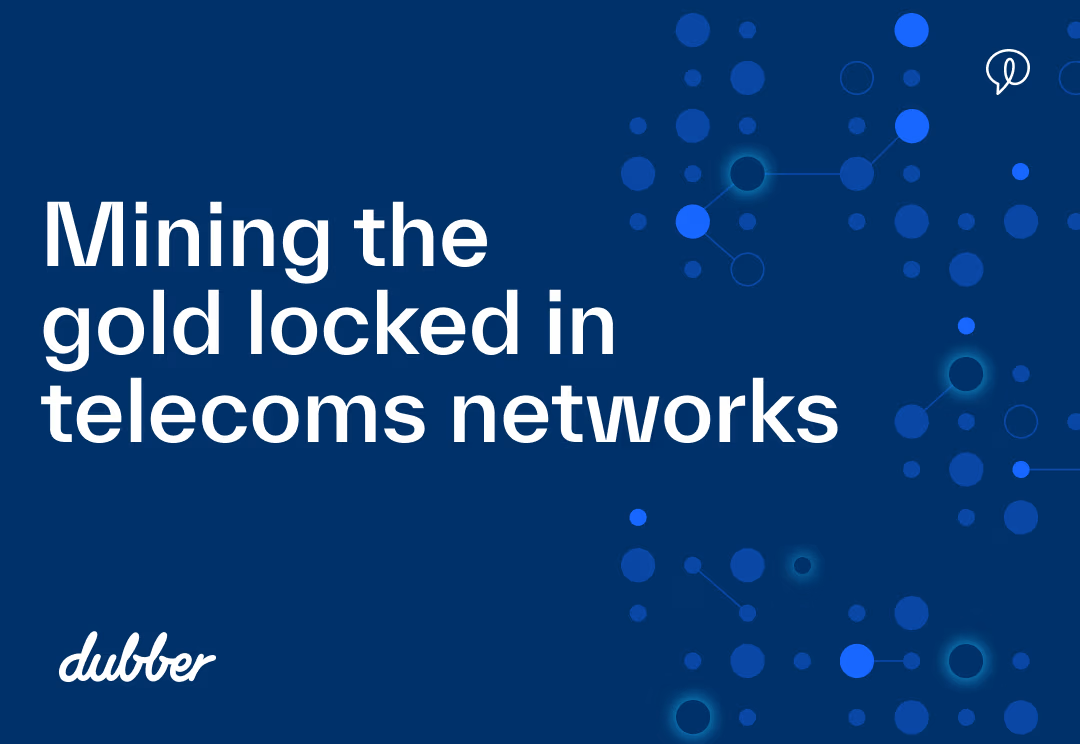
by Bill Bennett
Service providers have an opportunity to recapture the value in their infrastructure.
Telecommunications technology changes fast. Telcos and other service providers face ever-increasing infrastructure investments to stay competitive. Upgrading mobile networks to 5G or building fibre to the premise needs more capital.
Each year they spend hundreds of billions of dollars. There is no let-up in sight.
Meanwhile, there is no corresponding revenue rise. Customers get more data and faster data with each passing year although the price they pay remains steady. They get more reliable connections. Traditional telecommunications companies around the world built networks that millions turned to when they had to work from home.
When they look at the future through a traditional telco lens, they see few opportunities to add value.
Competing with free
Moreover, the value-added services telcos were able to sell in the past are now given away for free.
Technology companies provide free or low-cost digital services running on top of fixed-line and wireless networks, often, but not always, funded by advertising sales.
Take the free messaging offered by Facebook, Google and Apple. It can be advertising-supported or as a lure to sell hardware or other digital services. Zoom, Teams and Webex replace telco-provided video conferencing. The list of free or low-cost over-the-top services goes on.
Streaming video, music and gaming are other classes of over-the-top services that rely on networks built and maintained by telcos
To rub salt in the wounds, over-the-top companies continue to clock up record revenues and enjoy high margins.
Meanwhile, telecommunications experiences flat to decreasing revenues, increasing capital outlay requirements and reducing opportunities to differentiate.
Telco share of the online digital universe is decreasing
When comparing telcos to these tech companies the numbers make for sobering reading. The profits of the world’s top 25 telcos has fallen 46 percent. Their share of revenue is down 40 percent. Their share of the market cap dropped 60 per cent.
Meanwhile, the likes of Google, TikTok and Zoom are heading in the opposite direction. It’s no coincidence that Apple and Microsoft are among the world’s most valuable companies.
The telco sector’s long-time fear of becoming little more than a series of pipes could soon be reality. There’s irony in this: none of the new value the over-the-tops generate would be possible without the networks. They are the enabling technology.
There are other challenges. Governments around the world have different regulatory goals, but their rules often work to increase competition, which in turn keeps margins low. It’s not unusual for telcos in a contested market to compete all the profit away.
The logical conclusion of where the markets are heading is that telcos have lost the battle for opportunities on the network. However, things are quite different if we look in the network.
The opportunity is in conversations & content
All the extra value created by over-the-top companies comes from conversations. People and businesses need to communicate with each other. It remains as valuable as ever.
For over-the-top companies, those conversations take place on top of the network.
There is another set of conversations with untapped value. We’re talking here about the millions of conversations people have every day when they make voice calls on their mobiles or fixed-line phones through traditional telecommunications networks.
These conversations take place in the network.
Each of those conversations could hold as much value as those taking place on the over-the-top services. They represent an opportunity for telcos to win a much higher average revenue per user.
Moving beyond connectivity
Telcos have found it hard to move beyond connectivity in the past. There are huge barriers. Over-the-top players are not restricted by national boundaries, networks inevitably are.
The skills needed to develop and market digital services were expensive and hard to attract to firms unable to distribute start-up equity or offer seemingly unlimited career opportunities. That’s less the case today, skills are more widespread and, thanks to the cloud, technologies often need less complex integration.
Tapping into the conversations that take place in a network is one set of opportunities beyond connectivity. Other trends have potential.
Organisations with large on-premise call centres are shifting to cloud-based systems. They need flexibility and to be able to support new modes of working including home-based call centre staff.
Bigger than connectivity
Connectivity services typically deal in large numbers: customers serviced, call minutes, data traffic and so on. The numbers can be equally large beyond connectivity.
And unlike connectivity, where the number of customers is at saturation point, the market for in-network services holds huge growth potential. The examples are endless:
- Deployed at the heart of a Service Provider network, Dubber Notes users now get any meeting or call transcribed – turned into actions – with highlights and more. A user can review meetings I wasn’t able to attend on the way home and easily share highlights for action by others.
- Another service might deliver a text nudge following a call with all the key actions from the call. Or a reminder of a meeting I committed to during the conversation to drop onto my calendar.
- Or, mobile services might come with an app that quickly flags customer and employee sentiment for that day – and provides snippets from customer calls a manager should know about.
- A major bank could receive from their Service Provider a fully integrated compliance reporting dashboard that gives total visibility into calls that potentially breach policies. Or, a simple search console that enables them to pull up highlights, a recording or a transcript of any conversation across the business. That same application would prove invaluable to HR, dispute resolution teams, or customer service managers.
All of this is possible today. And this is just the start of a new era in which every conversation is a source of value for the service provider – turning the network into n innovation factory with endless new services created and deployed with minimal CAPEX investment.
Many of today’s business challenges are best dealt with from in-network services
Many businesses face challenges that are best addressed by value-added services telcos can offer from within their networks. There’s an ever-increasing compliance load, especially of those companies operating in and around the finance sector where record keeping becomes critical.
Conversational intelligence is an ideal way to capture the necessary information. It makes sense to do that at the network level. It makes even more sense for capturing and mining the conversations in the Network to take place in the Cloud where vast amounts of data can be stored safely and securely.
AI opens the door to a new frontier
Moving from connectivity services to capturing vast amounts of conversational recording data opens the door to new frontiers with even greater potential to disrupt and reshape telco business models. Voice call recordings already enable AI technologies like sentiment analysis, where customers can instantly read reports on how customers respond to conversations.
Understanding this opportunity changed our orientation at Dubber from the utility of call recording to the creating a platform that will enable value to be created from any conversation on the network – to enable the content on the network to unlock new sources of innovation and the creation of new, needed experiences for customers.
We believed that the majority of providers looking to enhance the value of the network had it wrong and we would get it right – and that the focal point needed to be the Service Provider:
- Solutions delivered to you should enhance the value of the network through differentiated services – not monetize the network at your expense
- Those solutions should be burdenless – deployed with simplicity and scale – on with a click – integrated easily with billing and provisioning
And that they must unify applications and end-points. So conversations – text, video, mobile, UC – could be accessed and enriched in one conversation cloud. - And that this could enable endless AI-based innovation opportunities for service providers with minimal CAPEX
Mining the gold in the network starts with native services the Service Provider can monetize and provides the pathway to increased revenue, retention and differentiation.

Download the case study to learn how Surf Life Saving NSW can focus on the mission of saving lives with Dubber call recording and AI.
Learn how Surf Life Saving NSW:
- Gathered crucial evidence with accurate and immutable records of all calls for coronial enquiries and investigations.
- Saved critical time with automatic transcriptions of every call that can be copied and pasted into incident reports saving critical time.
- Used AI-powered sentiment analysis to identify calls needing further review, and listened to recordings for staff training.
“Dubber improves our response speed. It frees up the operators to focus on the rescue, helps us prepare evidence for coronial enquiries and improves reporting accuracy. Together these make us more professional as an organisation and an emergency service.”

Did you catch Dubber on CommsDay?
Recently, James Slaney, Co-Founder and COO of Dubber, sat down with Grahame Lynch from CommsDay, to chat about the challenges Communication Service Providers are facing and how they are uncovering hidden value on their networks thanks to the power of Dubber.
“Service providers are telling us they have traditional issues such as differentiation. There are growth problems. They’ve got pressures with churn of customers. They’ve had massive investments in 5G and growing those networks and delivering; how can they leverage those investments and dragging the revenue or the benefits of those networks.” – James Slaney, Co-Founder & COO Dubber
Why Service Providers are turning to Dubber to unlock value from network conversations
Against a backdrop of regulatory and supply disruption, changing customer behaviours and tech innovation, service providers are under constant pressure driven by a need to differentiate mobile offerings, shifting value pools and profit erosion, resulting in decreasing returns on invested capital.
Dubber hits that sweet spot for Service Providers globally; as a network-grade service that’s embedded into the network. Dubber addresses traditional telephony, mobile networks, and Unified Communications services, unifying voice data and delivering insights, actions, and meaning from not only singular conversations but within departments, business functions, and the enterprise as a whole. Critically, Dubber network-native services enable service providers to unlock new revenue streams through conversations on their networks.
When, where and how conversations occur has changed
The conversational era is upon us. Gartner estimates that by 2025 – 75% of business conversations will be recorded and analysed for business intelligence and decision making. Covid has accelerated Hybrid work resulting in an explosion of end-points, conversation modalities and the imperative for businesses to digitise.
Despite the changes in where, when, how and on what device or platform conversations happen, the service providers’ network infrastructure underpins it. With the benefit of Dubber, service providers can orchestrate and enable customer, people, revenue, compliance intelligence, and dispute resolution by unifying voice data with AI, all from natively embedded services within the heart of the network. Dubber empowers service providers to position themselves to deliver and capture value answering their need to differentiate, create new value pools and retain customers.
The Dubber difference driving Service Provider differentiation, retention & profit
As a sticky product with cloud-native infrastructure and scalability that can be switched on with a click, over 170 service providers worldwide partner with Dubber to provide value for customers in a network-native, simple to deploy and flexible, innovative service.
The Dubber Difference:
- Embedded as a service and connected at a network layer – highly resilient and telco-grade platform
- Deliver differentiated services and accelerate innovation
- Increased revenue from an in-demand service – Near-instant time to market and revenue-generating from day one – Dubber is highly profitable, margin accretive
- Increased retention
- Requires no CAPEX neither for you (the CSP) nor for end-customers
- No unnecessary cumbersome installations required
- Intuitive cloud-native, easily accessible and modular
- Backed by comprehensive support (support, helpdesk, security)
- Tap into innovative capabilities such as NLP, AI & ML
Speak to us and learn how we enable service providers to unlock the potential in their networks.
Download the whitepaper by leading telecommunications industry analyst firm Cavell Group, to discover the key trends impacting service providers and what every service provider needs to do next.

As Cisco’s leading partner for Unified Conversational Call Recording and Voice AI, we’re looking forward to participating in Cisco Live from June 13-16 in Las Vegas as a Collaboration Village Sponsor.
This is your chance to see the only preferred native and embedded call recording solution at Cisco Live. Dubber is native as a standard feature in Webex Calling Multi-Tenant and Dedicated Instance – an immediate benefit to every customer and a pathway for every Cisco Partner and Seller to drive richer Dubber solutions with a click.
We’ll be demoing Dubber, showcasing case studies and have great prizes and gifts waiting. Come on by!
Dubber is proud to be the most complete recording solution on all major Cisco platforms. With Dubber, Cisco customers across all industries now have the opportunity to unify conversational data capture and analytics, revealing the critical insights largely left untapped within voice, video, and chat.
In response to the new reality of hybrid-working, the unification and capture of all communication is vital to the transformation of enterprise working models and in delivering advanced functionality to drive innovation and collaboration across organizations.
For Cisco customers, the Dubber platform drives innovation, revenue, and retention as a hyper-scalable and instantly deployable secure cloud-based solution. With just a click of a switch, users can securely share and unlock meaningful insights and actionable intelligence enriched with conversational metadata and unified in the Dubber Conversational Cloud.
Here are some of the highlights of what you can expect from Dubber at Cisco Live:
- Speaking session by Adrian, Di Pietrantonio, Co-Founder and Executive Vice President of Global Platforms & Partnerships at Dubber
- Join Adrian in the Collaboration Village on Wednesday the 15th of June at 3:30-3:45 pm for a session on how Voice AI can address the challenges associated with hybrid work and unlock valuable insights for your business.
- Visit the Dubber kiosk & chat with a voice data expert
- Visit us at the Collaboration Village, CL11 – E&F, and speak to one of our experts to learn how Cisco’s preferred private and compliant recording solution can be turned on and used in your enterprise.
- Loads of prizes are up for grabs!
- Don’t miss out on the chance to receive a free demo of Dubber on Cisco’s major platforms and go into the running to win Dubber merch or an Apple Airtag!
So, in the spirit of the Cisco Live 2022 event tagline “ALL IN”, we’d love for you to join us and go ALL IN with Dubber at Cisco Live. Come see us at the Collaboration Village, CL11 – E&F, from June 13-16 to learn more about how Dubber can optimize your business by helping to ensure compliance mandates are met, improve customer and employee intelligence, reduce revenue leakage, expedite dispute resolution and turbocharge productivity. You don’t want to miss this!
Book a face-to-face demo of our platform or a meeting with one of our senior executives at Cisco Live. We look forward to seeing you there!
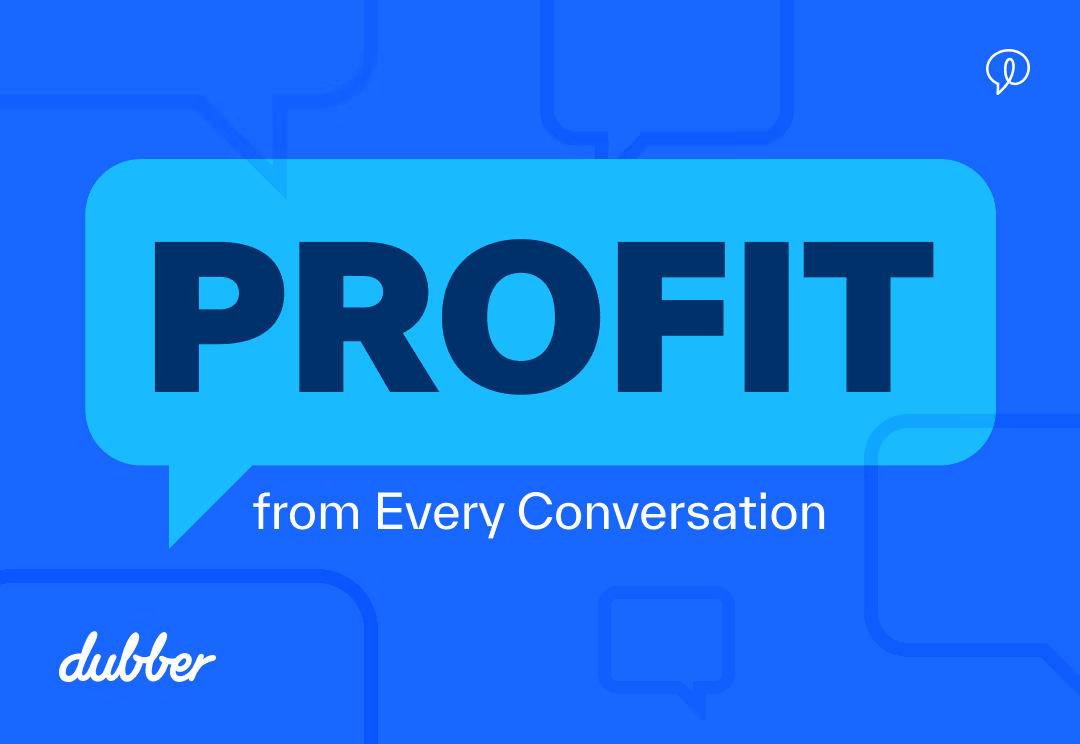
Service provider communications infrastructure is the backbone of society. However, the ability to generate value from these networks has diminished and is increasingly challenged.
As a critical infrastructure, telecommunications is highly valued by businesses and the community and vital to the current and future success of the economy. Despite this, it is frequently viewed as little more than a utility. Understanding future value creation for service providers of every kind requires a shift in focus from the network as a utility to the network as an exponential source of value based on the content flowing on it. Doing so enables us to reimagine the potential of the network and unlock the huge social and productivity benefits that our sector can deliver.
Conversations are the life of the network
Conversations make the network – they are the life of the network. Hundreds of billions have been invested in network infrastructure to make them possible – with more still to come.
Despite this investment, we constantly hear from service providers about their difficulties extracting value from the network.
“Over the past decade, telcos have been under continuous pressure as their traditional value pools have gradually eroded and new growth horizons have proven elusive, driving return on investment capital (ROIC) ever closer to weighted average cost of capital (WACC).” – McKinsey, A Blueprint for Telecom’s Critical Reinvention.
Now, ROIC is barely higher than WACC and falling – caused by high and rising requirements to invest CAPEX into network infrastructure. Network expenditure is forecast to rise significantly over the coming years as operators deploy 5G and edge-cloud networks, recasting consumer and enterprise value propositions in the process.
At the same time, telcos have seen other players in parallel verticals monetise the value of the network. Globally, the share of profit of the top 25 telcos has declined by 46% versus internet companies; the share of market cap has declined by 60%, and the share of revenue has declined by 40%, all while Google, Microsoft, Zoom, Facebook et al. have grown exponentially.
The pressure is unrelenting with the accelerating growth of OTT providers and MVNOs. None of these companies would exist without the demand for a conversation on the network. The need to communicate – to collaborate on work – to connect with friends and family drives their value.
But if conversations are the life of the network – why haven’t we been able to monetise the content they are made of? Why isn’t every unit of a conversation a source of ever-increasing value? And, why are others making more money running on the network than those investing in the network?
Unlocking value from the network through conversations
Already, Gartner predicts that 75% of business conversations will be recorded by 2025. This isn’t for compliance or traditional call recording requirements as we know them today, but because conversations are an extremely content-rich source of data that is now able to be enriched with artificial intelligence (AI), machine learning (ML) and natural language processing (NLP). Together these technologies make it possible to surface customer satisfaction and revenue insights in real-time and resolve Customer and Employee disputes efficiently. And meetings turned from time-wasters to productivity boosters.
When, where and how conversations occur has changed substantially. A new conversational era is upon us with employee and customer behaviour leap-frogging ten plus years. Remoting working has been matched by an acceleration in remote selling and service.
In 2021, video conferencing skyrocketed, with 82% of Australians starting or increasing their usage. Much of this shift was accelerated by COVID and the drive to hybrid working – it didn’t just change where we work, but how we communicate and when we work. Unified Communications exploded – challenging Telcos across everything from control of the customer to tech to margin.
And the pace of this shift isn’t stopping. Global UC spending is projected to grow at a 5% CAGR to reach $53 billion in 2025. Microsoft has surpassed 270 million monthly active Teams users globally, while Cisco Webex Calling has hit a record 8 billion monthly calls. And in 2021, Zoom grew Australian users by more than 54 times. And now 5G is set to create further opportunity – mobile will matter more than ever before, resulting in more endpoints and new kinds of end-points more connected than ever.
So how to service providers extract value from these shifts?
The first step in extracting the value of content and conversations on the network – and this starts by turning them into meaningful data sources by embedding conversational capture as a native feature of the network. Compliant, secure and scaleable capture enables AI-enriched insights and data to be produced from transcribed content in full or fragments.
From content in the Dubber Conversation Cloud, new services and applications can be developed rapidly based on data derived from conversations. At the most basic level, new subscription-based services fuel potential revenue at twice that of the service costs.
Dubber’s suite of service provider embedded products capture conversations across all endpoints and unify them – representing a unique opportunity to generate value from the network, no matter how people communicate.
By increasing revenue, retention and differentiation, we can change the economics of the network together.
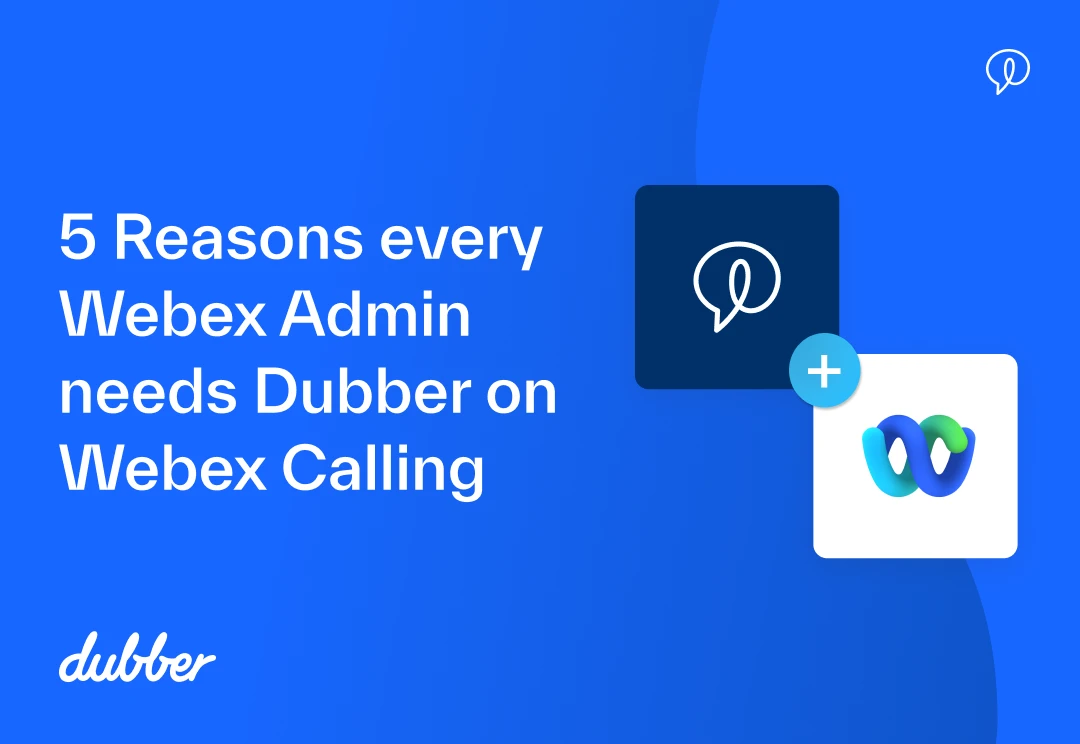
5 reasons why every Admin needs to turn on Dubber on Webex Calling
Dubber private and compliant cloud call recording is a native feature of Webex Calling, easily provisioned by any Webex Customer Administrator. More than half a million businesses and users (globally) have been using Dubber to record their crucial business conversations.
Are you the Control Hub Customer Admin?
Call recording insights are now considered imperative in achieving better business outcomes. Organisational leaders are looking for an edge, whether that’s better use of voice data or an increased ability to glean insights and intelligence from every business conversation.
Webex Calling customer administrators now play an essential role in enabling their business and users to unlock the value in every business interaction and power conversational intelligence at scale. With a predicted 75% of conversations being recorded by 2025 (Gartner), the trend is set to stick.
So how does Dubber on Webex Calling stand up against competitors and enable businesses of all sizes to achieve business outcomes? Here are five reasons.
5 reasons you need to switch on Dubber on Webex Calling for your business:
1. It’s FREE. Zero additional set-up cost. Zero additional hardware.
All Webex Calling users have access to Dubber’s enhanced cloud call recording capabilities at zero cost covered in their Webex Calling subscription. You can eliminate the cost of legacy call recording solutions today and simplify the pathway to unlocking the benefits of conversational insights and AI.
2. Natively embedded, instantly provisioned and intuitive onboarding
Dubber is the first multi-tenant call recording solution born in the cloud that’s natively embedded into Webex Calling. Dubber is securely interconnected to the Webex Cloud, making it simple, automated, and instant to switch on through Webex Control Hub. Admins have complete control and easy user management. Admins can effortlessly provision 1 or 1-thousand users or leverage dedicated customer success experts for support, including an intuitive concierge-level onboarding experience for admins.
3. Enhanced cloud call recording for business needs
All Control Hub admins need to do, is switch on call recording in Control Hub for their users. By doing that, they enable enhanced compliant cloud call recording capabilities for all Webex Calling users. All recordings are centralised in the Dubber portal with unlimited call recording, replay and download with 30-day storage. Dubber on Webex Calling users will have the ability to record, pause/resume and record on-demand on mobile or the Webex app (Desktop/mobile).
4. Centralise your voice data compliantly – Built for Hybrid (Webex Calling & Webex Dedicated Instance)
As an Admin, if you’re managing the transition from UCM on-premise to Webex Calling, you can use Dubber to meet all your call recording requirements. With Dubber, cloud call recording is compliant, secure and unifies your voice data in one platform. This approach enables a streamlined hybrid experience and management for you as the Administrator.
5. Dubber is a Cisco Solution Plus Partner
As a Cisco Solution Plus partner, Dubber has long been a trusted vendor across the Cisco ecosystem. For this reason, Cisco is Dubber’s first partner in the Dubber Foundation Partner program. The partnership unlocks for all Webex Calling & Webex Dedicated Instance customers a tailored, securely embedded and compliant cloud call recording, bringing a best of breed capability as a stand feature. For Webex Calling customers and customer Admins, the experience has been designed with ease of adoption and simplicity in mind. This makes Dubber the most complete recording solution available on all major Cisco and Webex platforms.
Interested in learning more?
Dubber on Webex Calling is making cloud call recording easier and more accessible for businesses to unlock the value of their rich conversational data. To learn more, get in touch with us here.
To compliment Dubber on Cisco, Dubber also has a range of solution packages purpose-built to solve Compliance, Customer, People and Revenue intelligence outcomes powered by Dubber’s voice-ai platform. Reach out here for a tailored demo.

Lights, camera, action!
We’re proud to announce our debut ‘Blockbuster’ sponsorship of Gamma’s 2022 Roadshow, ‘Gamma at the Movies’. This year’s theme is, ‘Mission Possible: Making new markets’.
Dubber is changing the economics of legacy on-premise call recording, opening up new opportunities for revenue growth, customer retention and product innovation with the Unified Call Recording and Voice Intelligence platform.
We’re excited to showcase the Dubber solution to Gamma channel partners up and down the country in June and showcase how they can start to 2X the value of every deal with compliant cloud-based conversational recording and voice AI.
- Tues 14th June – Vue, Glasgow Fort, Glasgow
- Wed 15th June – Vue, Salford Quays, Manchester
- Tues 21st June – Cineworld, NEC, Birmingham
- Wed 22nd June – Vue, Cribbs Causeway, Bristol
- Tues 28th June – IMAX, Waterloo, London
Innovate your UC offering and increase your ARPU today with Dubber – see you at the show!

Who said what? Dual-stream recording on MS Teams is a way to end not knowing – critical for hitting compliance mandates within organisations. When dual-stream recording is switched on, call recording quality goes up.
Benefit: More accurate transcriptions, leading to better conversational intelligence insights
Benefit: Discrete record of who said what, even when both parties are talking at once
When a conversation happens on Microsoft Teams – whether it is a Teams-native platform conversation, or an Operator Connect call via Microsoft Teams Calling with PSTN integration – dual-stream recording can be your default option with Dubber.
How dual-stream recording for Microsoft Teams works on Dubber
Dubber’s dual-stream recording on Microsoft Teams records two audio separate streams – one for the host, one for the participant – in stereo recording.
On calls with more than two participants, the host speaker is recorded on one channel, with the other participants on the second channel.
In Dubber transcripts, the recording is then broken down to show the host as Speaker One (Left) and the participant as Speaker Two (Right). This also aids in transcription accuracy. When replaying recordings in their audio form, the host or speaker one will be reflected in the left headset channel and the participant or speaker two will be reflected in the right headset channel.
Why dual-stream recording is critical for compliance
In compliance activities, it is imperative that internal speakers’ words are captured succinctly, and always extracted as that person. Speaker identification through AI, such as in our Notes by Dubber application, is a handy tool, however for absolute knowledge of who said what, without the chance of misidentification, a dual-stream capture provides immutable proof. This also eliminates cross-talk, which can confound understanding and recall.
Example case: ASIC’s Best Interests Duty RG 273 obligations
Under ASIC’s Best Interests Duty RG 273 obligations, mortgage brokers must be acting in the best interests of the customer at all times. With Dubber, dual-stream recording can ensure the broker’s conversations are recorded and transcribed with full attribution and separation, plus stored and recalled for as long as is necessary.
Example case: FINRA Rule 3110. Supervision
Under FINRA Rule 3110, a system must be set up to supervise associated persons for compliance with applicable securities laws and regulations. This includes “review of securities transactions that are reasonably designed to identify trades that may violate the provisions of the Exchange Act, the rules thereunder, or FINRA rules prohibiting insider trading and manipulative and deceptive device.” By using Dubber’s dual-stream recording, this makes it easy to instantly review and recall conversations, even based on keywords or particular people.
Try dual-stream recording on Microsoft Teams to meet compliance mandates
Dual-stream recording is available now on MS Teams. Head to Microsoft’s AppSouce to get Dubber Unified Call Recording for Microsoft Teams or download our guide: How to ensure compliance on Microsoft Teams.

